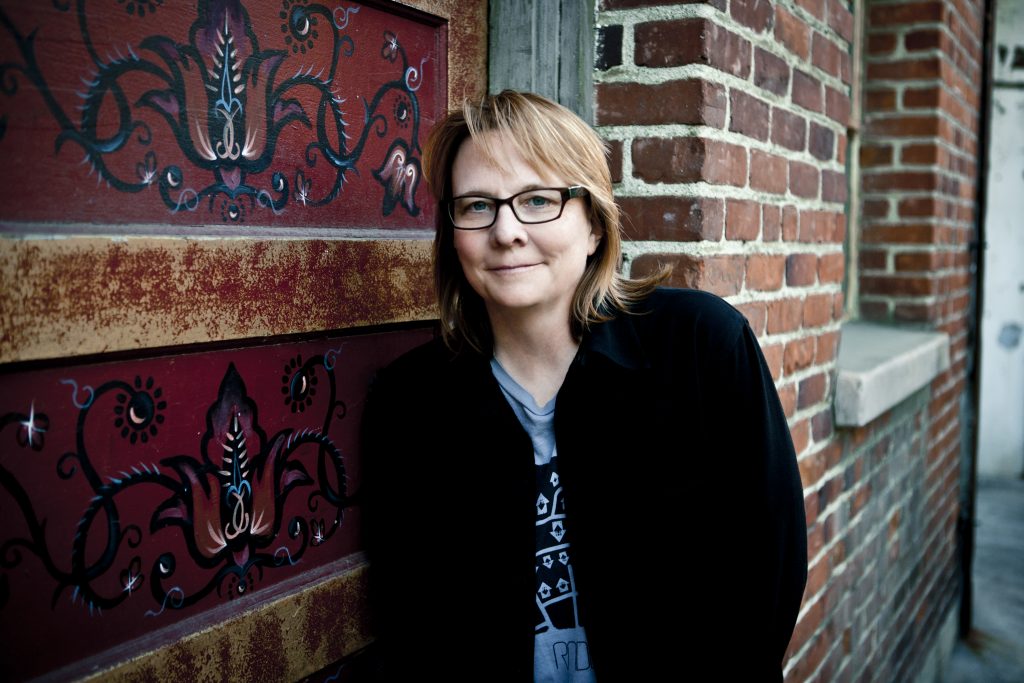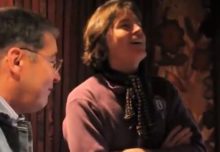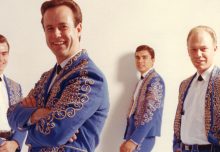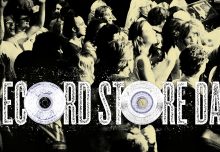December 10, 2016
Archival project brings Alex Chilton masterpiece to life Omnivore Recordings’ Cheryl Pawelski completes Big Star’s Third
December 9, 2016 08:09 AM

Omnivore Recordings’ Cheryl Pawelski worked for a decade piecing together Big Star’s Complete Third. Photo Supplied, Greg Allen
Big Star never got to make a third album. Back in 1974 Alex Chilton, Jody Stephens and friends recorded more than enough material to put something out but little of it was heard until earlier this year when Omnivore Recordings released Complete Third.
It’s brilliant stuff. The “critics’ darlings” from Memphis outdid even themselves in laying down track after track of sublime southern gothic pop filtered through Chilton’s singular genius.
Big Star released two classic albums in 1972 and 1973 (#1 Record and Radio City) that very few people actually listened to back in the day. The band (originally consisting of Chilton, Stephens, Andy Hummel and Chris Bell) rarely played live although in one memorable gig they performed to a room full of rock critics.
In some respects Chilton didn’t know how to do anything else. An unlikely pop star at 16, fronting The Box Tops on the massive Top 40 hit “The Letter,” he’d seen it all way too soon. On Complete Third the edgy angst-ridden performer wrestles with personal demons while still attempting to create the perfect pop tune.
Fragile deconstructions like “Holocaust” and “Kanga Roo” were a tough sell in a radio-friendly environment but Chilton was always searching for something darker anyway.
There is some speculation that the recordings he made with producers John Fry and Jim Dickinson were never meant to be a Big Star record and were instead intended as a Chilton solo album. At some point he seems to have lost interest in the material or was pushed out of the way and the tunes languished for decades on the shelves in Memphis’ Ardent Studios.
Thanks to Omnivore Recordings and Cheryl Pawelski we now get to hear Chilton’s work in context from roughs through to demos and finished tracks.
For more than two decades Pawelski has worked on the preservation of archival recordings. Before co-founding Omnivore in 2010 she held positions at Rhino Entertainment, Concord Music Group and EMI-Capitol Records producing recordings, reissues and boxed sets for a wide range of artists.
Last year her work on previously unreleased Hank Williams material, The Garden Spot Programs, 1950, was recognized with a Grammy for Best Historical Recording.
Pawelski has built her career helping artists to create definitive statements of their music. This week she spoke to the North Shore News about Omnivore’s epic efforts to reconstruct Big Star’s Complete Third into a coherent record.
North Shore News: How did you get my dream job?
Cheryl Pawelski: (laughing) Well, I started as a temp. I quit a job after college I had back in Milwaukee and I went to work at a record store so I could learn more about distribution and then I moved to L.A. I became a temp at Capitol Records and I was there for 12 years.
North Shore News: You’ve seen the music industry go through many changes including the shift from analog to digital, from vinyl to streaming.
Cheryl Pawelski: It’s funny when I first started I was doing side splits for cassettes and LPs and now I’m back to doing side splits. That’s how this business is. To quote Fairport “It all comes round again.”
North Shore News: Omnivore Recordings seems like it was built to handle all aspects of the industry. You’re like a one-stop shop for all musical formats.
Cheryl Pawelski: We like to say we are format and genre agnostic. If there’s great music why not put it out? And if people want to buy it one way or another way—great. It’s never made sense to me to not get as much music out there. I’ve never wanted to be stuck in one genre. If it’s good music, it’s good music.
North Shore News: You collect records yourself.
Cheryl Pawelski: Occupational hazard. Ever since I was a kid. My grandma used to work at a department store and she offered to buy me something one day when I was there. I could have got anything but I pinched her for two records. I remember these little wire racks in the back in the electronics section of the store and I still have them. I bought an Anne Murray record, “Snowbird” and “The Candyman” by Sammy Davis Jr. with “I Want to Be Happy” on the flip side. Both of them were budget reissue titles.
I’ve always been fascinated not just by the music but the thing, the artifacts. How things are constructed both sound-wise and in the packaging and how decisions are made to put music out. I like to collect all kinds of things—I have everything from reel to reels to digital minidiscs and all that other stuff that came out.
North Shore News: A lot of formats had short life spans.
Cheryl Pawelski: Because people could put a lot of digitized music on a thing they tried. I got pitched all kinds of stuff when I was at Capitol. There was one guy who came in with something just a little bit bigger than the size of a quarter and he was very proud, he said, “I can get 300 songs on here. Don’t you think people would want to buy this?” I said, “Well, A, it’s going to get lost and, B, if you can get 300 songs on there you have to pay royalties on 300 songs so the price is going to be exorbitant. I think that’s why those thumb drives didn’t work so well, they’re just too expensive. Royalties still have to be paid.
North Shore News: Mastering engineer Michael Graves writes on his blog about going back to the sources on the Hank Williams set (Hank Williams The Garden Spot Programs, 1950) to make new transfers. It seems like your projects involve a lot of detective work.
Cheryl Pawelski: Once we started Omnivore I got to explore more of that part of the business. When you work at a label your job is to work with the assets that the label owns but once we started Omnivore I got to sleuth things out more which is really fun. Leads like this come from all over.
The Hank Williams was a really wonderful project. A friend of mine is a DJ in Dallas and a big music collector. He buys collections and he wound up buying this giant collection that had these transcription discs in them and one thing led to another—the next thing you know I’m sitting in Nashville with Jett Williams, Hank’s daughter, pitching a project. Thankfully my friend was willing to let Mike borrow the original transcription discs because Mike is one of the greatest restoration guys out there. He did an amazing job. I love working with Mike and the whole detective thing is made even better because we have him as a resource. He can make stuff sound pretty great as long as there is information on the tape or the disc or whatever is there.
North Shore News: Do you consider Omnivore’s approach different than say Rhino’s? Did what you envisioned about starting a label play out?
Cheryl Pawelski: My last port of call was at Rhino, in fact all the partners at Omnivore have had some affiliation with Warner Music Group. I was the head of A&R there before we started Omnivore. Rhino’s job, as part of the Warner Music Group, is to work with the assets of the Warner Music Group. With Omnivore we just have so much latitude to work with anything that we want. That’s the biggest difference. We’re only limited by our imaginations. I’ve been able to run a little wilder, within reason. I mean we still have to try to make a living. It’s been kind of a freeing experience creatively for me.
North Shore News: That’s how some people think Chilton felt around the time of the Third sessions. He wasn’t tethered to label expectations. Omnivore Recordings is all over the Big Star story. How did you originally make the connection?
Cheryl Pawelski: I was at Concord between Capitol and Rhino. Stax had distributed the first two Big Star records. They were purchased masters. When I got to Concord we were working on Stax’s 50th anniversary and I was going and back and forth to Memphis a lot, which is not a bad thing. I was always a big fan of Big Star but the fact that they were just purchased masters means that at the time Ardent sold the LP and whatever associated singles there were. Any outtake material and stuff still belonged to Ardent. As I went from Concord to Rhino (I discovered) Rhino had a license on Big Star’s Third through their acquisition of Ryko. It was just like with Stax. Concord had acquired Fantasy and the Atlantic distributed years of (the Stax label). It was a similar thing to the first two albums. One piece of it resided at Concord and one piece of it resided with Warner Music Group. I was able to do something that hadn’t been done before because I had relationships at both places and we were able to do more comprehensive releases of Stax material.
I think Stax 50th may have been one of the first compilations to include both sides. When I landed at Rhino I had already been talking to (producer) John Fry because at Concord I was sort of the custodian of the catalogue. When I got to Rhino I said, “Now we can start putting this stuff together.” It was fortuitous that I went between the two entities that had the rights to all of the material.
North Shore News: Despite it’s chaotic history Third has a lot of material. Is that unusual?
Cheryl Pawelski: No, not really. Some artists go into the studio and record the 12 songs they need but there might be demos or preproduction demos. With Third you obviously know the history of that record, it was a little bit crazy. There should actually be more. That’s the sad thing. Alex apparently had a tendency to grab just any old tape off the shelf and start recording. Just like The Basement Tapes, right? They recorded over stuff and you’re missing things so who knows what happened.
It took awhile to find more of the material. I was on the hunt for awhile and thankfully Jim Dickinson’s estate was forthcoming with some tape that I kind of had a feeling existed but it wasn’t sitting in any vault that I’d crawled through. They were really helpful. We were able to pull it more together. That’s when I knew we had a more complete picture of Third because Jim’s rough mixes were really revealing. It would have been a much different record if he’d finished it.
North Shore News: Is the Dickinson material the second volume in the Complete Third?
Cheryl Pawelski: It’s at the tail end of Disc One into Disc Two and then in the middle of Disc Two Fry’s mixes start. You can hear the record being pulled more toward the finished masters in John’s mixes. I was thrilled when we found Jim’s stuff because it was like the little missing chunk between the demos and what little bit of session material we had. I was fascinated by that. It’s funny, I get involved in these projects that take so long that I don’t remember what the original tracks sound like. If you just threw out a Band song title I probably wouldn’t be able to tell you what record it’s on because when you work with the outtake material so much you just kind of lose perspective. I was kind of worried about Complete Third because it had been 10 years of listening to all this material. I was going through the test pressing for Volume Three the other day listening to the original masters for the first time in a long time and I was like ‘I don’t remember that being on there.’ It’s just a bizarre experience but it’s happened before. When you’ve lived with something for so long and you don’t have to go back to listen to the released version it all sounds bizarre. So this one turned inside out. I was really worried there wasn’t anything there.
North Shore News: You’ve been working on Third for 10 years. At what point did you discover Jim Dickinson’s rough mixes?
Cheryl Pawelski: Within the last two years. I was looking everywhere that I thought they could be once I was able to talk to the Dickinson’s and they really went over and above because it’s just a bunch of tape. They had to get it to Ardent. I’m in L.A. They’re in Mississippi. Somebody had to get the tape there. They were amazing.
North Shore News: What form were the tapes in?
Cheryl Pawelski: Multi-tracks and quarter-inch. Except they were pretty rough. We did the best we could restoration-wise but the tapes were in really poor condition. There were a couple of things that we couldn’t salvage unfortunately.
North Shore News: Would you have put the project out without the Dickinson mixes?
Cheryl Pawelski: That was part of the thing. Kicking this around for a long time. When John was still alive it was really something he and I put a pin in. We did the test pressing of the vinyl as the first Omnivore project. I said to him at the time, “you know at some point we should pull all the Third stuff all under one roof” because we had put some out on the Keep An Eye On The Sky box set on Rhino. Some of the stuff was on the documentary soundtrack, there were bits and pieces of it all over the place. I said, “you know it’s a fascinating record because it’s not really a finished record, we should tell the story.” And he agreed but we just couldn’t finish while he was still alive. Once I pulled all that stuff together it still felt like there was a hole. And so Adam (Hill) at Ardent and I were asking people who were still alive at he time where there might be more sources. And the Dickinson thing came very late. I was struggling with it as a release until we got that material. It was a missing chapter. I don’t know if I would have put it out.
North Shore News: You seem to be about the only person who could have put the album together. You knew the backstory and where everything might be hidden under layers of other stuff. It’s almost like a documentary film telling a story, following a linear progression from the rawest of raw demos to finished tracks. You were able to do that because you were able to piece together all the different sources.
Cheryl Pawelski: It felt like that was the way to kind of watch the record being made and I use the word ‘record’ loosely because it wasn’t a record it was a bunch of sessions. I felt once we had the two sets of rough mixes it had that arc building to finished masters. It made sense to me to tell the story that way. Stuff was just taped over. They weren’t keeping pristine tracking sheets.
North Shore News: The record was never actually a record but Dickinson and Fry were apparently shopping something and Chris Stamey actually bought a bootleg of tracks at the time.
Cheryl Pawelski: Jim and John took it around to all the labels. Famously they got responses from heads of labels saying things like, “Do I have to listen to this again?” It didn’t go over so it sat. They made a concerted effort to get it out in the world and then just put it up on the shelves.
North Shore News: You mentioned you are working on the vinyl issues right now?
Cheryl Pawelski: We’re just finishing up Volume Three. Some people like to buy big expensive box sets of vinyl—I think that’s just cruel. Not everybody can afford them so we broke it up into three double albums. Each one represents a disc in the box.
North Shore News: Is the third volume what maybe a finished Third would have sounded like?
Cheryl Pawelski: It depends who would have finished it. The finished master that they were shopping—the test pressing—I don’t know who chose the songs that went on there, I guess maybe John would have, maybe Jim. It seems to me, just because I remember those first two Big Star records were purchased masters. They sold the record as it was.
My argument here is that they might have done that with the test pressing. Everybody has their favourite sequence of these songs but because those first two were purchased masters I thought maybe they were shopping the test pressing and they would have sold it as it was. That’s why I used it as sort of the foundational sequence because some of the people who were involved in the sessions—maybe not Alex because he was famously cut out of the end process—but some of the people that were involved with it thought that was a good thing to shop around. So I have to imagine that that was probably the record they wanted to make.
The choices are strange though considering all of the material that’s there though so who knows? If you look at the track list on there it goes from “Stroke It Noel” to “Downs.” Songs one and two and then into (a cover of the Velvet Underground’s “Femme Fatale”). Who thought that was a good idea?
There were so many other options. There is so much wonderful music that was recorded. The songs are beautiful. The original PVC went from “Stroke It Noel” to “For You” which maybe works better? I don’t know. When you’re listening to the original demos the songs are glorious—for me to go from “Stroke It Noel” into “Downs” is like, wow, what?
North Shore News: Are there many projects like Third that take such a long period of time to produce?
Cheryl Pawelski: It’s kind of funny because they float around for a long time. A project takes its own time. I feel if I try to force something into release sometimes it doesn’t run out the way it should. I always talk about them like they are animate objects. They get to be released when they want to be released. They swirl around in their various stages. Some things are just ideas and then I will be in a record store or I will read something and another piece will be added. For me they kind of happen when they want to.





